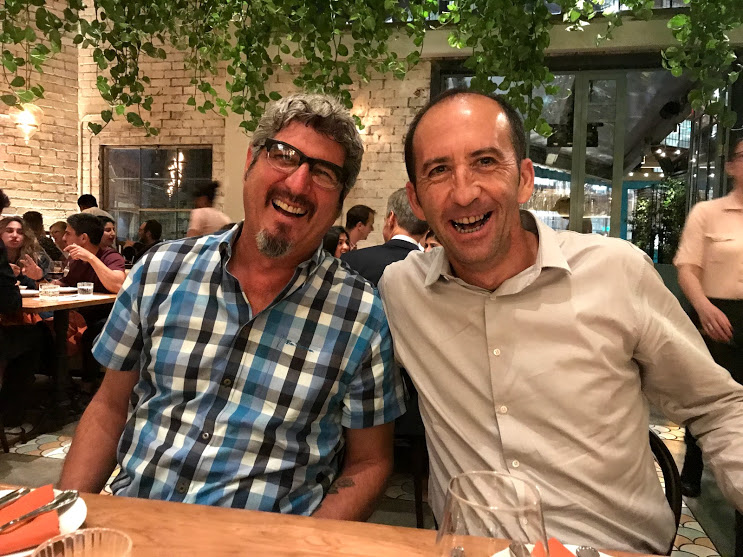Roussillon Meets Hollywood: A Visit from Jean Marc Lafage
I love meeting winemakers. There is so much to understand about a glass of wine but learning about the person and story behind it appeals to me as much as what’s in the glass. And winemakers are a passionate, interesting bunch. Their stories are usually full of twists and turns, and, at the very least, a whole lot of heart. Jean Marc Lafage certainly is a winemaker full of heart, though he’s smart and thorough and works as precisely as possible in both the vineyard and the cellar. This week, I had the pleasure of getting to know him.
First thing on Monday morning, we sat down at K&L and talked brass tacks. Both Jean Marc and his importer, Jean Philippe from European Cellars, were basking in the glow of France’s recent World Cup win, but we quickly got down to the meat of the meeting: what Jean Marc does at his winery in Roussillon and what he’s trying to do with his wine. We talked vineyards and soil and cellar. He took over his father’s bulk wine business around 2000, and he quickly turned the barebones operation into something completely state-of-the-art. His team members walk around with remotes on their belts that can monitor the exact level of oxygen in the wines at every stage of the process. Yet, these are not over-produced wines that he is making. His main objective is to correctly match the right varietal to the specific terroir in the first place, so that the vines thrive. If he’s planted correctly, he doesn’t need to mitigate various climate influences, just manage the vines. He and his team work organically and sustainably and think about the long-term health of their vineyards. His description of process really seemed like a symbiosis between raising good material in the field, then protecting it every step of the way.
I learned so much about Roussillon while speaking with him and researching. What a wild, unique place. It has one metaphoric foot in Catalonia and one in France. Though it’s lumped in with Languedoc, it’s a very different place culturally, historically, and vinously. Per Jancis Robinson: “Quite unlike the flat coastal plains of the Languedoc, Roussillon's topography can be guessed at by the fact that today it is effectively the département called Pyrénées-Orientales, the eastern section of the Pyrenees, a mountain range so high that much of it remains snow-covered throughout the summer.” It is France’s sunniest climate, and it also bears influence from the nearby Mediterranean sea. Plus, rocky soils, fierce wind--it has so many different climatic factors giving it a very unique sense of terroir.
Then, the next day, we got to sit down to dinner and I learned more about who Jean Marc is. He’s a warm, charismatic person. He is a passionate Catalan who learned French, Spanish, Catalan, and English growing up. His daughter is beginning to chart her own course in the winemaking world, just off to start an internship at Gary Farrell winery, and his teenage son loves tennis. He and his wife, who is from the Languedoc, make wine together, so the children really grew up immersed in this world, watching their parents build from the ground up, seeing both their struggles and triumphs. In 2001, they produced 2000 bottles; this year they produced 5 million.
We ate at Bavel, a new Mediterranean restaurant in the Arts District by the good folks at Bestia. The meal was just completely on point that night. The wine list had an eclectic selection, pulling from France, Spain, and Italy, but also Greece, Lebanon, and the Canary Islands. The food—grilled octopus, lamb neck shwarma, mushroom kebab, duck confit, duck sausage hummus, citrus-marinated olives, topped off with a mulberry ice cream—harmonized beautifully with the bottles we chose. We drank the 2016 Yves Cuilleron St-Peray “Les Potiers” 2016: Marsanne and Roussanne from a phenomenal producer in the Rhone, showing stone fruits and blossoms on a luscious palate. We moved on to the 2013 Glinivos Vlahiko from Ionnino, Greece—an indigenous grape to the Epirus region, not usually bottled as a single varietal, so a rare find. A delicious, medium-bodied wine that sang with ripe mixed berry fruit and black peppery spice, with soft tannins that made it the perfect match for the food. Both are producers we carry at K&L, but it was fun to try different cuvées from them.
It was truly lovely to sit down and break bread with Jean Marc, Jean Philippe, and Keith, our French Regional Buyer/Guru. If there’s a better way to learn about wine, I can’t think of it! So, a big thank you to all three for your knowledge and friendship. Stay tuned for more on Lafage in our French Regional newsletter, which will land hot off the presses very soon!
- Kate Soto













